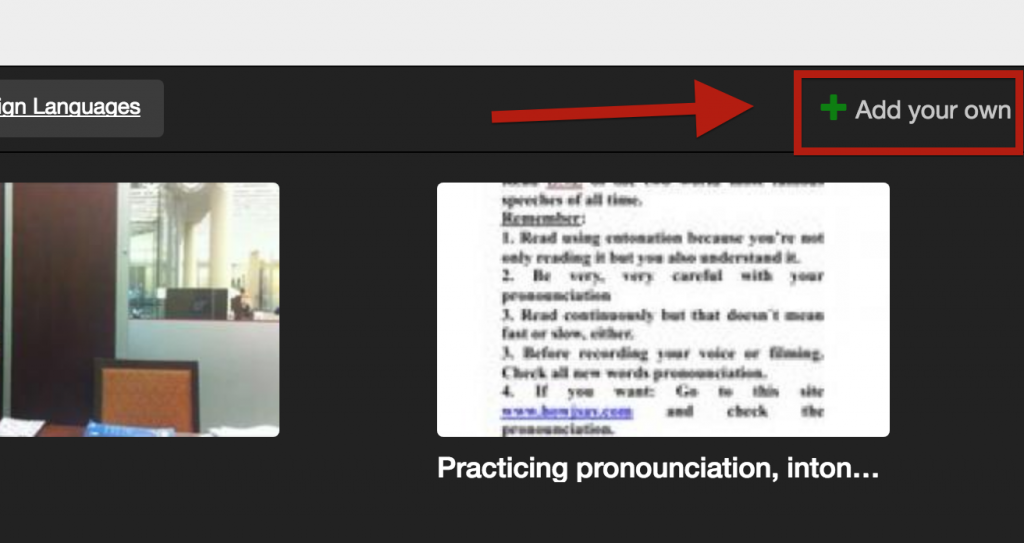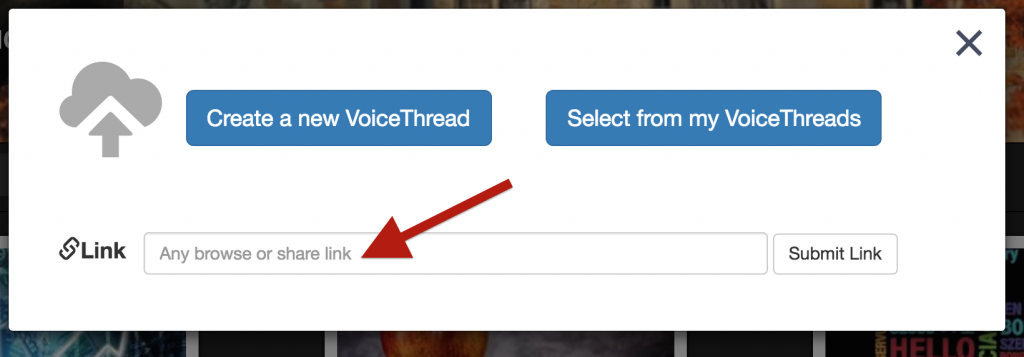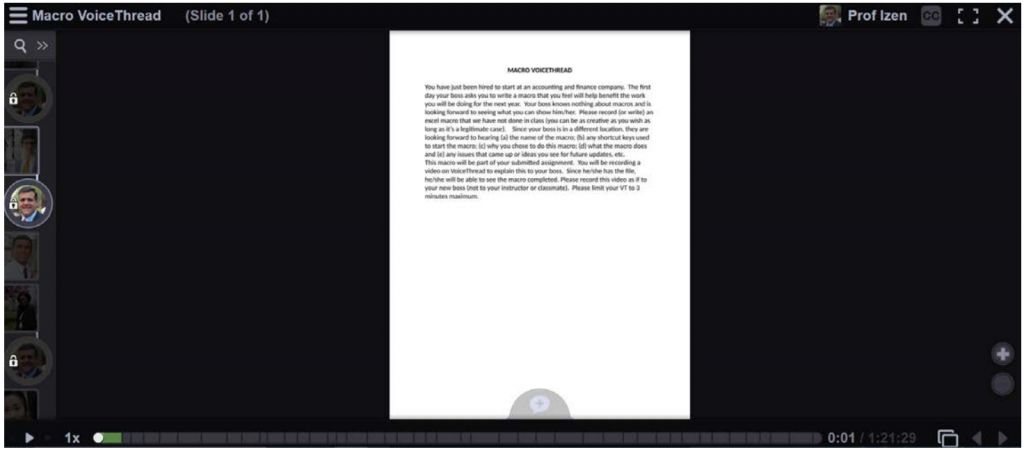
What’s new in 2018?
No More Flash

We’ve reached the finish line! VoiceThread is officially Flash free, and the new HTML5 version has been released to everyone. It’s been a long journey, and we’re very excited to have moved on to this phase. The HTML5 version of VoiceThread offers:
- Options to speed up or slow down comments as you’re watching or listening.
- More responsiveness with less software to install and run.
- Greater security since you no longer need to have Flash installed on your computer or web browser.
Expanded Conversation Channel

Open up the conversation channel on the left side of your VoiceThread to see more information about comments, including the commenter’s full name, the date and time stamp, the duration, and the type of comment, all at a glance.
Mobile Accessibility

We’ve streamlined VoiceThread Universal to be more mobile friendly and to launch seamlessly from the standard VoiceThread mobile app. We’ve also eliminated all Flash from these pages. This makes it easier for blind users and others who utilize screen readers to interact with VoiceThread.
New Infrastructure

Security and infrastructure are always ongoing efforts, but we’ve made some great strides this year. All infrastructure has been upgraded to be faster, leaner, and more secure. We’ve also taken all steps required to defend against known vulnerabilities like Spectre and Meltdown.
What’s next?
You already can interact with and comment on video extensively in VoiceThread, and now we’re developing even more integration. Soon you’ll be able to insert your comments into your videos so that you can see where each comment was recorded on that video’s timeline. Nothing about how comments are recorded will change; you’ll just have more information at your fingertips about where the comment was made.
New Assignments and Courses
We’ve been telling you about courses and assignments for a while now, and we’re proud to say that things are going very well! Soon we will have “New Assignments” available for LTI-integrated institutions to try out. Some of these new features will include:
- Greater variety of assignment types and more collaborative options between students
- More grading options
- Enhancement of existing assignment types based on your feedback
- Streamlined workflows for both instructors and students
- Tighter mobile integration
This will be the first step on our way to offering self-contained courses within VoiceThread, as well. Soon you’ll be able to run a course in VoiceThread that is both simpler and more flexible than the groups you use now.
Accessibility Goals
We’re always working toward greater accessibility of VoiceThread. The specific goal this semester is WCAG 2.0 AA compliance. This includes many small details to ensure that VoiceThread is accessible to all users.
Educators around the world like to share their work and now VoiceThread has a way to let everyone know what you’ve been working on too! Our public Browse page is a great place to see VoiceThreads from different subjects for both K12 and Higher Ed courses. On the Browse page, you will see different ThreadBoxes for each subject.

You can search for a ThreadBox about your subject and see what others have shared, then you can share your own!

You will be able to search a list of the VoiceThreads you’ve already created or simply paste the link for the VoiceThread you would like to add.

It is always helpful to see what other educators in your field are creating, so don’t be shy! Share your work with others and connect with our global community.
This is a guest post by professor of Law & Ethics and VoiceThreader, Matthew Phillips.
Today was the first day of classes for my university, but it was also a snow day. I drove into work anyway, in part because I’m just that stubborn and in part because I wanted to be ready for my classes, which were having their first meetings tomorrow (what was to be the second day of school). By the time I got to campus, it was clear that we would be experiencing a delay (at best) for the second day of classes too.
I’ve used VoiceThread as a just-in-time snow day solution before, but this was a bit more complex because it would be covering my first meeting with students. There was also the possibility that only some of my classes would be canceled, so the virtual session would need to match up well with the in-class experience that students would have in afternoon classes.
Here are some of the highlights of my approach to this VoiceThread project:
- Invest in the introduction: I wanted students to have a clear introduction to me as an instructor, so I taped an introduction with my iPhone (and a good mic with extension cable). I did some quick editing in Camtasia before uploading to VoiceThread, but I could have easily uploaded the file directly to VoiceThread after trimming with the iPhone’s native tools.
- Tell students why this is good for them: I’m sure students would prefer not to have any snow day work, but that would create an awkward beginning to the semester. I tried to outline exactly why I created this virtual class session (so that they’d understand the course framework before they needed to master next week’s readings), and to be upfront about the fact that I like snow days too, but their learning outcomes drove me to take this extra step.
- Adjust for the medium: VoiceThread is great for sessions like my introductory class—lecture with supporting slides—but it’s still different than being in person with students. I usually try to inspire students a little about the power of openness and curiosity with regard to my discipline, and I also usually push a little when talking about participation and use of electronic devices in class. I dropped those parts of my introduction because I’d rather do those things when I can see their reactions and adjust tone and content accordingly.
- Invite comments specifically and provide instructions: I know some students won’t have used VoiceThread before my class, so I specifically invite comments, and I use a text-based comment to mention that the option exists, because I don’t necessarily want a dozen students adding video comments in this context (though that’s a great VoiceThread feature!).
- Be careful about lighting and angles: It’s not hard to get the camera—even a laptop webcam—aimed properly and to get lighting to work to your advantage. I put my computer on a stack of books so that the camera is at my eye level (avoiding the “up-the-nose” angle that’s so common with webcams. I also turn my desk lamp so that it’s shining at my face from just beside the computer so that my face is not dark and doesn’t have bad shadows. Those may seem like shallow issues, but they communicate your investment to students: I need them to know I took this seriously so that they will too.
Good luck! Stay safe, warm, and on track with your syllabus in the new year.
About the Author:
Matthew Phillips is the John Hendley Fellow and an associate teaching professor of law & ethics at the Wake Forest University School of Business and the director of Wake Forest’s BB&T Center for the Study of Capitalism. Phillips has won teaching awards from Wake Forest and from the international Academy of Legal Studies in Business. You can find him on twitter at @mtppilot and you can find his school at @wakeforestbiz.
The concept of “flipping” the classroom has been around for a number of years but it hasn’t been widely adopted as a professional development strategy. Why is this the case? In a traditional face-to-face course, students are required to attend classes at a certain time in a specific classroom so their schedules are predictable. Professional development workshops for faculty are typically not as predictable. Scheduling workshops for teachers can be a difficult task because of after school activities, department meetings, office hours and a host of other obstacles.
VoiceThread can help trainers at all levels overcome these obstacles. Over the last few years, we have worked with a number of Instructional Designers and Learning Support staff to create and deliver flipped workshops. In the past, trainers may have been able to cobble together tutorials and documents to share with teachers, but VoiceThread makes organizing materials and follow-up discussions easier. Instead of compiling half a dozen links to YouTube videos, webpages and in-house materials, you can upload all of your content to one place. You can narrate over slides, share screencast videos and have an open Q&A all on a single VoiceThread.
Because VoiceThread is asynchronous and web-based, there is no need to schedule, reserve meeting space and deal with all of the logistics that go along with professional development. Many teachers want professional development, but those obstacles can get in the way. A teacher may have time to learn at 10pm on a Thursday, or early in the morning on the weekends, and VoiceThread allows these teachers to enjoy the benefits of PD without having to upend their schedules.

As teachers work through the material, they can easily record their questions at any time of day. The facilitator of the VoiceThread workshop can then review the questions on their time and respond. If the answers are complex, the facilitator can upload a new slide explaining the answer in greater visual detail to that same VoiceThread. You can eliminate the back and forth of text-based emails and maintain a record of the questions where everyone can hear them.
There will always be a time and place for meeting with someone face-to-face to work through issues, but VoiceThread gives you the freedom to decide when that is necessary and when it’s not.
This is a guest post by VoiceThread Certified Educator Curtis Izen.
In my online and f2f business information courses, I use VoiceThread for a variety of assignments. This includes an “ice breaker”, transforming discussion boards, group PowerPoint and using individual research assignments to be shared for the entire class to learn from.
This semester, I wanted to try an assignment utilizing a feature in VoiceThread that I have yet to explore. In the assignment I created, students were tasked with completing an MS Excel assignment. Although the completed assignments were delivered to me via Blackboard, there was one component where I incorporated VoiceThread. Part of the task was for students to create a macro (series of repetitive commands that could be invoked using only the keyboard). Each student was to create a macro they felt could be implemented if they were recently hired in a finance or accounting firm. Once they completed their excel macro, they had to use VoiceThread to present their accomplishments to their boss. They needed to state why they chose the macro, what the macro does, what obstacles they overcame and how they could possibly move their final creation to the next level. I had set a limit of 3 minutes for them to present.
The feature I incorporated was comment moderation. This prevents other students from seeing their classmates’ comments. Students had to create their own ideas and couldn’t be swayed by their peers. The end results were excellent. I had 25 unique assignments that worked. I followed the student’s suggested comments on my own excel computer program. I was impressed by some of the creativity that was produced. Requiring the students to speak in front of the camera made them feel assertive with the material. It was as if their actual boss was on the other end. Some students went as far as dressing up.
I subsequently made a private voice comment to each student explaining my assessment of the video they produced. I soon realized I could use VoiceThread to not only analyze that component, but the complete assignment. I no longer need to write back my observations. I found it more effective and efficient explaining how certain tasks could have been accomplished verbally than anything I could have written. The one caveat is to review your VoiceThread replies and be sure that they have a line connecting the commenter to yours as well as a lock. If you find your comment is not locked, that comment will be visible to everyone. If you are looking for ways to engage your students, a VoiceThread assignment may be the solution.

About the Author:
 Curtis Izen is a senior information associate and VoiceThread Certified Educator. Curtis adjuncts online and face to face courses at Baruch College and the School of Professional Studies at the City University of New York. Curtis is passionate on bringing new philosophies and technology into the curriculum. He is a 2 time recipient of the Presidential Excellence Award for Distinguished Teaching and Pedagogy at Baruch College.
Curtis Izen is a senior information associate and VoiceThread Certified Educator. Curtis adjuncts online and face to face courses at Baruch College and the School of Professional Studies at the City University of New York. Curtis is passionate on bringing new philosophies and technology into the curriculum. He is a 2 time recipient of the Presidential Excellence Award for Distinguished Teaching and Pedagogy at Baruch College.
Have you ever used comic books to teach? Tim Smyth has, and he is ready to share his secrets with you in our first “Ask Me Anything” on VoiceThread! Learn how Tim has used comics to teach his high school students about the Civil Rights marches, Japanese internment camps, and more during this special, one-week only, online event.
Tim has helped hundreds of educators learn how to use comics to teach a variety of subjects like history, science, and classic literature, and he can share his strategies with you, too. If you and your students would like to participate, just open the VoiceThread below and record your questions for Tim! It’s that easy.

[](/wp-uploads/2017/11/SuperSmyth-2.jpg)
[](/wp-uploads/2017/11/SuperSmyth-2.jpg)

About Tim Smyth:
Tim Smyth is a high school social studies teacher of 16 years with a MS Reading Specialist degree who believes all educators are teachers of reading. He travels the country sharing the power of comics in education for both students and teachers. This VoiceThread will give you resources and lessons you can use in your classroom tomorrow, no matter your subject area or level!
This is a guest post by educator and VoiceThreader Dr. Daisy Sam.
I have been a classroom teacher since 2005. My only break from the classroom was in 2011 when my family moved from RI to NJ and this year school year as we made another transition from NJ to FL. Sometimes the teaching life is so involved you seldom have time to sit and reflect on the lessons you have created. You just keep doing what works and adapt to new approaches as they come. I truly believe that Teaching is an Art and my tools are a variety of web tools that enhance my lessons. One tool in particular that has been instrumental in my life as a language teacher is VoiceThread.
In the process of writing this blog I went through the many VoiceThreads I have created through the years. I realized that March 2009 was my very first one! Initially, I bought in because of the recording, annotating, and sharing features. Moreover, I was excited about the direct implications this tool had for my Foreign Language classroom of sixth, seventh and eighth graders. At first, I created groups for my classes and loaded VoiceThreads where I would record myself explaining a concept taught in class or pronouncing words. In a way, this was my version of a flipped classroom in 2009. As I developed more experience, I started using VoiceThread to enhance projects by showcasing them to parents on my Google Website. One project in particular was a fashion show. My eager seventh graders used a row of tables as their runway and recorded aspects of their show on VoiceThread. We shared it by embedding the thread in our class website. I then put VoiceThread in the hands of my middle schoolers and had them produce the extra lesson and explanations to share with the class. Additionally, I flipped my classroom readings during this time. Students would read in class and then for homework listen to me read a chapter. This process allowed them to continue to develop an ear for the language.
When I left RI for NJ, I also left behind my sweet middle schoolers. In Ridgewood, NJ I had the opportunity to teach high School. Not knowing how my “big kids” would react to VoiceThread I implemented it slowly. I quickly learned that high schoolers hate listening to themselves speak in Spanish! One of my first VoiceThread applications was having students recreate a scene from a story in our literature book. At this point, they were able to have their own VoiceThread account and join my class group. They recorded and shared their stories with our class group. As a classroom technique to get them out of their seats (World Cafe or Gallery Walk), we placed 1 computer at 4 tables. Each computer had a story from each group. I then asked students to rotate in groups and engage in discussion while providing feedback to the 4 stories. This was an “ Aha moment” when I realized that VoiceThread was a great source to provide verbal feedback. It was during this “Aha moment” that I really started experimenting and using VoiceThread for formal assessments. I wanted to give my students the opportunity to move past the grammar and speak the language in one place where I could also provide feedback. I needed a fast and convenient platform to do this and VoiceThread was that platform.
As I started teaching AP, it was clear I needed VoiceThread to help me not only create authentic forms of assessment, but also aid in the interpersonal skills needed for students to exit successfully from our Spanish curriculum. Part of the AP exam requires students to record a 2 minute presentation where they have to compare and contrast world issues of a spanish speaking culture and their own community. Needless to say, this was a challenge for many of them. We met this challenge head-on with VoiceThread. First, I posted a picture and the topic and everyone recorded their responses on the same thread. As a teacher this made it easier to grade. I knew I had to allocate a certain amount of time to listen to all of them. It showed me how long each recording lasted and with the VoiceThread App, I was able to listen to my students in my car, at the gym, at my kids practices, anywhere. This was beneficial for the students because it gave them an authentic opportunity for practice. The timing format allowed them to become vigilant of time constraints for the exam. When the assessment was over, I opened them so they could all listen to each other. The true strength of this application was the bi-directional learning that happened from student to student. Another aspect that is always a challenge of the AP exam is the simulated conversation and VoiceThread was a great resource for this. As a project they created their own simulated conversations which we embedded on a Google Site for incoming freshman. They had a good time coming up with discussion topics and it was a great way to share the expectations of the AP exam with teachers and students of the lower levels. In this website via VoiceThread, they also created listening practices, which also gave incoming students a perspective of what can be achieved at the higher levels
The use of VoiceThread not only assisted in enhancing assessments and practice skills for the AP exam, but its practical use found its was to my other lower level classes as well. In these classes, I often used VoiceThread to record Group conversations. This particular technique allowed me to float around the classroom and engage in conversation with students and grade these conversations at a later time. At times I took it a step further and used these same conversations as a homework assignment where students had to pick a group to listen to on the VoiceThread discussion of the day and then produce a written reflection of agreement or disagreement. VoiceThread allowed me to design much more meaningful and rigorous assessments. We moved from lower levels of depth of knowledge (DOK) of conjugating verbs to higher levels of depth of knowledge real, authentic conversations in Spanish. For instance, in my 5-Honors class, the exam went from a traditional final with multiple choice questions and grammar to a 25 minute group final with a Spider Conversational Expectation, which involved a conversation reflecting on everything including HS and their Spanish career.
In all, it is my belief that language acquisition is one of the hardest skills to develop. It demands a strong command of vocabulary, grammar, context and confidence. Most teachers, including myself at one point, spend time drilling student skills in vocabulary and grammar. With a “drill and kill” process, most students disengage and develop minimal skills. However, VoiceThread showed me and my students that there was another way to learn a language that was much more meaningful and rigorous. Through its simplicity and practicality, my students and I were able to engage in higher level DOK conversations, which maximize engagement and language acquisition. I cannot imagine any of my classes without VoiceThread and you shouldn’t either. Don’t just take my word for it, check out what my two former students had to say about VoiceThread.
About the author:
Dr. Sam, most recently was a Spanish Teacher and Technology Coach at Ridgewood High School, NJ. Although she is taking a year of from the classroom as she transitions her three children into a her new home state of Florida, she an active Google Education Trainer and Consultant for Eduscape Learning and New Wave Consultants. She has been in the field of education for over ten years. Dr. Sam has been using web tools in the classroom since 2008. In 2013 she became a Google Certified Individual and a Google Education Trainer in June 2014. She holds a Masters degree in Teaching and Student Learning and a Doctoral Degree in Education Leadership. Her 2011 Dissertation focused on how middle school teachers in the different areas of education, described their level of competency using technology and implementing the national education technology standards. In addition Dr. Sam has presented her session Using Google Apps and Web 2.0 tools for AP Success at the 2016 AP Annual Conference, NJ World Language Institute and has been a guest presenter at various World Language Departments in NJ. You can connect with Dr. Sam on twitter at @daisysam1.

Have you ever used comic books to teach? Tim Smyth has, and he is ready to share his secrets with you in our first “Ask Me Anything” on VoiceThread! Learn how Tim has used comics to teach his high school students about the Civil Rights marches, Japanese internment camps, and more during this special online event.
Tim has helped hundreds of educators learn how to use comics to teach a variety of subjects like history, science, and classic literature, and he can share his strategies with you, too. Next week we will share a special AMA VoiceThread with you so you and your students can join in the fun.
Whether you are a teacher, a student or you just love comic books, we hope you can join us during the week of November 13th for our first VoiceThread “Ask Me Anything”.
If you and your students would like to participate, just add your name to this list and we will send you the link on November 13th. Then, just record your questions for Tim! It’s that easy.


About Tim Smyth:
Tim Smyth is a high school social studies teacher of 16 years with a MS Reading Specialist degree who believes all educators are teachers of reading. He travels the country sharing the power of comics in education for both students and teachers. This VoiceThread will give you resources and lessons you can use in your classroom tomorrow, no matter your subject area or level!
[](/wp-uploads/2017/11/SuperSmyth-2.jpg)
This is a guest post by VoiceThread Certified Educator Donna Hanks.
VoiceThread has completely changed the teaching and learning dynamic of my online courses! Classes are more engaging, student participation is rich with information and providing feedback is simple yet meaningful!
I initially started using VoiceThread as a replacement to the traditional discussion board in my online Supervisory Management course. Rather than have students type out their thoughts to a question, self-assessment or case study, I have students use VoiceThread. VoiceThread allows students to easily prepare a video post detailing their analysis and ideas while making connections to concepts covered in the chapter. This has been a game changer in terms of student engagement, information richness and quality of peer to peer interactions. The quality of student posts far exceeds the quality of discussion board posts I was previously seeing.
In 2015 I started using VoiceThread in my online Project Management course. Not so much as a discussion board replacement but as a repository for project deliverables. Prior to VoiceThread students uploaded project deliverables to BlackBoard, I would correct them, write or type feedback using a rubric and return deliverables to the student. VoiceThread has changed all that! Students now upload their project deliverables to VoiceThread, prepare a video post to explain their deliverables, analyze how the information applies to the chapter concepts and sell me as to why they believe their work is an effective approach for the given project.
I then prepare a video post back to the students with my feedback and suggestions while using the pen functionality in VoiceThread to write corrections or suggestions right on the deliverables. All of this interaction is captured in one location! And did I mention? This is a group project so multiple students are working on the same project deliverables at the same time. VoiceThread provides a 360 degree approach to student learning!
Feedback I often hear from students is they feel like they are actually part of a class and not floating by themselves in an online world. They get to see their classmates each week and seemingly talk to them throughout the semester. Students are motivated by the opportunity to collaborate in VoiceThread so they look forward to completing their own work and interacting and learning from their peers. When was the last time a student told you they were excited to participate in a discussion board?
VoiceThread fosters a learning environment that is robust, interactive, relevant, and may I say…fun! So much so that I plan on using it to flip a classroom this spring for a course I teach on campus! I can’t wait!
So, if you are looking for a platform to jazz up your class, improve engagement and enhance student learning, my question would be…Why not VoiceThread??
About the Author:
Donna Hanks is a Business & Technology Instructor/Team Leader for Western Dakota Tech in Rapid City, South Dakota and VoiceThread Certified Educator. She can be reached at donna.hanks [at] wdt [dot] edu.
This is a guest post by Nursing Educator and VoiceThreader Kimberly Davis.
I attended the online VoiceThread Basics Training this past spring and was quickly hooked! One of the features that really appealed to me about using VoiceThread was the idea that students could use multiple modalities to express themselves. I teach Concepts of Professional Nursing, an introductory nursing course, where students have traditionally used a written discussion board post to answer how this class has shaped their professional identity. This summer instead of using the discussion board forum, I took the question to VoiceThread and had the students post their discussion using their own slides, video, audio, images, etc. This assignment became so much more interactive, and the student responses were truly inspiring!
Logistically, I wanted to make the discussion meaningful since I have 80 students in the class, so I divided them into groups of 10 to make it more manageable. After they read over and responded to each other’s posts, they then created an electronic poster presentation of just images to represent their group’s collective professional identity as a nurse. Each of the groups then presented their electronic posters to the class on our final day.
I think utilizing VoiceThread allowed for a deeper reflection since students were able to use color, voice, video, and imagery to represent their thoughts. As I read through their posts, there was definitely an underlying feeling that students were starting to realize how challenging the nursing profession will be. Some themes I saw in the responses included recognition of the complexity of patient-centered care/advocacy, importance of caring and safety, need for evidence-based practice, dangers of horizontal violence, importance of caring for self, etc. An unintended effect of this assignment was that I saw multiple encouraging responses between the students, such as “You will be an awesome nurse” and “I have no doubt in my mind you will be compassionate and knowledgeable to all of your patients! Your patients are going to be lucky to have you as a nurse!” Using VoiceThread for this assignment truly enhanced student engagement and contributed to their learning in a significant way.
Since I had such a positive experience in the introductory nursing course, I decided to implement VoiceThread into a reflection activity with my community clinical group this semester. Since this is a service learning course, students are expected to participate in meaningful reflections of their community-based experiences. This semester I started posting their reflection questions on VoiceThread and gave them editing rights which allowed them to add their own slides after my introduction so they could then respond to each other with voice, text, video, and imagery. I have led this reflection activity for several years now using a traditional written discussion board forum. Typically students have responded to the minimum number of posts as required, however, this semester I noticed a higher level of engagement with some students responding more than this required minimum. Reflecting with VoiceThread has been a success!
Another feature that enticed me to implement VoiceThread was the editing ability. I am program director for the Care Coordination Certificate program at our university, which is 95% online. The first course that students take in the program includes an overview of the United States healthcare system. We identified early this year that pre-recording these lectures was not going to be in the best interest of the students due to the rapidly changing health care environment. For the instructor, the editing features of VoiceThread are ideal when content may change from week to week (or even day to day!)
We are able to prepare lectures and re-record over one slide at a time, or even exchange slides, all without having to re-record the entire lecture. This editing feature has been a huge win for the faculty in the program who need to be able to quickly adapt to an ever-changing health care environment. It’s also wonderful in an online program that students can add questions and comments directly to the slides throughout the lecture. This promotes engagement when learning is asynchronous, and inserting audience response questions is a great way to break up the content.
Implementing VoiceThread has been a big win for me and my students this year! Faculty are excited about using this tool, and students are more engaged in the learning activities.

Kimberly Davis, MS, RN, CNE is a Clinical Assistant Professor at Virginia Commonwealth University’s School of Nursing in Richmond, VA. She teaches in a variety of undergraduate nursing courses with a special focus on community health nursing. Kimberly also serves as core faculty for the Center for Interprofessional Education and Collaborative Care and is program director for the Care Coordination Certificate at VCU, an interprofessional post-baccalaureate graduate level certificate targeted to health science students. You can contact her at daviskd5 [at] vcu.edu.

















